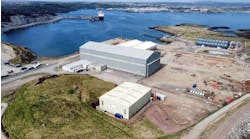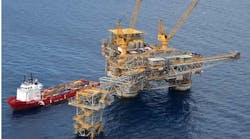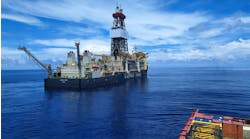DEEPWATER MOORING: Full taut-leg polyester drilling unit mooring established in Gulf of Mexico
The successful connection of Diamond Offshore Drilling, Inc.'s, deepwater semisubmersible Ocean Confidence to an eight-leg preset taut-leg mooring, incorporating polyester rope (7-in. diameter) and suction embedment plate anchors (SEPLAs), was successfully completed late in September of this year in the Gulf of Mexico.
Reels of polyester loaded on the deck of the CAHT Dove.
This project marks the first time that a mobile offshore drilling unit (MODU) has been moored with full-taut-leg polyester mooring outside Brazil. This technology will allow vessels to be moored in water depths to 10,000 ft and beyond. It is the first commercial application with a complete mooring system of CSO Aker Marine Contractor's (CAMC) patented SEPLA and BSW Ltd.'s top entry subsea inline mooring connector. This cost-effective and efficient anchoring system allows an anchoring system installation with one trip by a large anchor handling vessel (AHV).
In the case of the Ocean Confidence, the water depth ranged from 6,100 ft to 6,400 ft, which makes it significant in terms of advancement of deepwater mooring technology. The Ocean Confidence, is drilling for BP America, Inc. with partner Exxon/Mobil in Mississippi Canyon Block 822.
Theory joins technology
Overview of one leg of ocean confidence polyester taut leg mooring.
Each mooring leg comprises a combination chain/polyester/chain configuration, anchored to the seafloor with a 2,000 kip capacity SEPLA. The rig was originally fitted with Pusnes 3-in. diameter chain wildcats and column fairleads. To allow the existing equipment to be effectively utilized, a 2,000 ft length of 3-in. diameter Ramnas ultra-high strength chain (K4 plus grade), with a capacity of about 1,650 kips, was substituted for the existing K4 chain on the rig (with about 900 ft nominally outboard of the fairlead when attached to the mooring system).
This was connected to 8,500 ft of parallel strand, torque-neutral polyester rope (in five individual sections), which in turn was connected to a 1,000 ft section of 3 1/4-in. diameter K4 chain acting as the ground chain. The subsea connector attaches the ground chain to the 250 ft section of K4 anchor forerunner chain terminating in the SEPLA.
Marlow Ropes (UK) Superline parallel strand polyester rope, was selected based upon its properties and previous use in several permanent mooring systems in Brazil. Torque-neutral rope was used offshore in this application since no six-strand wire is included in the Ocean Confidence's mooring equipment. Current industry practices utilize torque-matched polyester rope in conjunction with wire rope systems to minimize fatigue in the wire.
Implementing project
The project was successfully completed in three phases. The first phase was installing the anchor system up to the subsea connectors using the Edison Chouest AHV. This vessel was equipped with a CAMC 300 ton A-frame. During installation, several SEPLAs were stowed on the deck with the installation follower. The A-frame was effectively used to reload each of the eight SEPLAs into the follower for deployment of individual mooring legs. Phase 1 was completed in a seven-day period.
Phase 2 of the installation involved deployment of the subsea connector, 1,000 ft ground chain, and 5,500 ft of the polyester rope in each leg. The deck of the installation vessel Dove was loaded with reels of polyester rope to complete this phase of the project. The polyester was spooled from storage reels to the main anchor handling winch drums and then deployed under load, section by section. These components were attached to the anchor system with the male part of the subsea connector. This phase, which was carried out offshore, required four days.
Phase 3 involved the deployment and attachment of the remaining polyester rope sections to the rig. It is current industry practice that polyester rope should not contact the seafloor. Therefore, it was necessary to use two installation vessels, the Dove to deploy the 3,000 ft remaining sections of polyester and the Seacor Vanguard to suspend the polyester sections clear of the seafloor.
Details of the Subsea Connector.
Similar equipment and methods were used to deploy the polyester rope during both pre-setting and rig connection paying out rope at about 100 ft per minute. The polyester rope was later connected to the rig chain and while the rig tensioned the chain, the mooring was lowered and released simultaneously by the two AHV's. Final Phase 3 rig connection was completed in two and a half days








